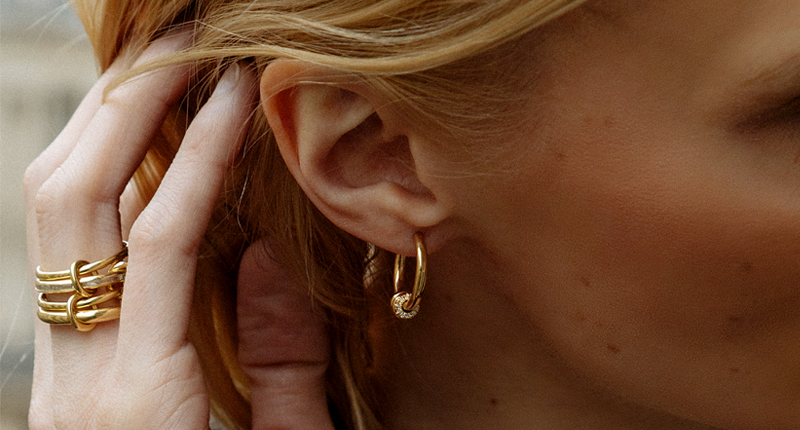Executive Chairman Richard Baker will take over the role as rumors swirl that a bankruptcy filing is imminent for the troubled retailer.
Designers Say E-Commerce, Instagram Sales Provide a COVID-19 Bright Spot
The pandemic has changed fine jewelry sales but not stopped them.

New York—More than 30 million Americans have been laid off since nonessential businesses were forced to go remote in March, but some jewelry designers’ businesses are faring the COVID-19 pandemic better than expected.
“Jewelry is a very personal purchase, and people are still treating themselves,” said Yves Spinelli, one half of the Spinelli Kilcollin husband-and-wife design duo.
“We had a strong wholesale business going into this and that revenue has decreased with most retailers shut. The flipside is that we’ve seen a major increase in our own direct and e-commerce business, which means that our net profit has increased substantially.”
Spinelli Kilcollin’s Los Angeles production has been shut down since the March government mandate in California, but cancelled trunk shows and store orders left the company flush with product to ship.
Serendipitously, Spinelli Kilcollin had just hired a customer relations manager to oversee the burgeoning direct-to-consumer business, who joined the team as the country shut down in March.
“She’s been hugely instrumental in driving sales by managing our client lists and keeping up with the increased direct messages and email campaigns,” said Spinelli.
“We also have a dedicated sales team who engage our clients through video chats, emails, phone calls, providing custom renderings, so we were prepared to focus our attentions there.”
Business-wise, the pandemic has proved to be an accelerant on omnichannel selling’s already bright flame, rewarding those companies that have embraced selling not just through ecommerce but also directly on Instagram, and forcing reluctant parties to step up their game.
New York City-based Reinstein Ross, which has stores in the Meatpacking District and Upper East Side, went through an adjustment period to the new business-during-COVID normal, but has found an upside amid the disruption.
“Direct sales have actually tripled for us,” noted General Manager Jennifer Lavorante. “Although most of our clients prefer coming into the store to shop and try on jewelry, they are becoming more comfortable with shopping online and speaking with our sales team to assist in their buying decisions.”
Reinstein Ross is shipping its customers in-stock inventory and taking special orders, though at a delay due to reduced production capacity.
The company is seeing demand for jewelry with meaning and symbolism—a sentiment echoed by several sources interviewed for this story—as well as gifting items for graduations and birthdays, particularly stud earrings, necklaces and bracelets.
“It's given us an opportunity to

New York City-based designer Ashley Zhang has had less success during the pandemic.
The cornerstone of Zhang’s business is her custom bridal work, which is on hold until production restarts.
Attempts at production of her core jewelry line are also impossible, with her design molds locked away for storage at her caster’s shuttered facility.
Still, customers are purchasing what she has available, including lots of antique and vintage jewelry items. They’re doing so a bit through her website, but more so on Instagram.
“During this time people are using social media to stay connected, so sharing, posting, and connecting with followers has been very successful,” she said.
Fellow New Yorker Grace Lee noted similar obstacles, as she is unable to produce the custom bridal work that accounts for the majority of her business.
“Our sales are down 80 percent year-over-year,” said Lee.
She said web sales of stocked inventory have stayed consistent, but are only a small chunk of her overall business.
For brands that don’t rely on custom as their bread and butter, like Spinelli Kilcollin, many are selling out of their inventory and scrambling to make more amid limited and delayed production.
It’s a tricky subject for companies, as several designers who asked not to be named noted. They don’t want to appear to benefit from the current climate, but their customers are shopping while stuck at home and they’re doing their best to meet that need.
The result is a strengthened designer-client relationship that, albeit remote, feels personal.
“We are learning how to speak to our customers from afar and seeing that through thoughtful and meaningful conversations, our customers truly trust us and want to keep connected,” said Lavorante of Reinstein Ross.
“Clients want a form of connection now more than ever before. They are calling, emailing and sending chat messages through our website to talk about jewelry and life in general. We have to show compassion and ensure them we will do our best to service-the same way we did before this all happened. We are also learning to run our business differently than we did and focus more efforts on direct-to-consumer.”
Spinelli agreed that business during the pandemic has provided a pivotal learning experience.
“This is a unique time to examine our businesses and ensure that they are aligned with our values and our clients. It’s important to stay positive and creative to see the opportunities available, as challenging as that may be,” he said.
“We’re thankful for our direct clients, and excited that we’ve been picking up many new ones through Instagram and our website. It’s going to be essential for brands and retailers to get creative on how to continue engaging with their clients and providing bespoke service.”
The Latest

Mohr had just retired in June after more than two decades as Couture’s retailer liaison.

Shekhar Shah of Real Gems Inc. will serve as president of the Indian Diamond & Colorstone Association in 2026.

How Jewelers of America’s 20 Under 40 are leading to ensure a brighter future for the jewelry industry.

This year’s good luck charm features the mythical horse Pegasus, and is our first Piece of the Week of the new year.


Articles about crime, engagement rings, and a necklace worn in the World Series generated the most interest among readers.

As part of the leadership transition, Sherry Smith will take on the role of vice president of coaching strategy and development.

Roseco’s 704-page catalog showcases new lab-grown diamonds, findings, tools & more—available in print or interactive digital editions.

It marks the third time the country has headed the Kimberley Process. Ghana will serve as vice chair.

The new Bulova x Stetson designs highlight two animals often associated with the American West—the bison and the Texas Longhorn.

Its residency at Yamron Jewelers will run through May 2026.

From influential executives to innovative designers, we pay tribute to the people we said goodbye to this year.

The retailer is expanding into areas with large Indian and South Asian populations.

The Italian brand has opened its first flagship amid the peaks of the Dolomites in Madonna di Campiglio, Italy.

The new curation at the Natural History Museum of Los Angeles County showcases rare gem and mineral specimens in their uncut, natural state.

The couple pleaded guilty to concealing at least $127 million in cash transactions at its precious metals businesses.

Consumers shared concerns about prices, inflation, tariffs, trade, and politics in the survey’s write-in response section.

In February 2026, the auction house will move its headquarters to the former Steinway Hall, a neoclassical landmark on Billionaires’ Row.

The new show will take place Jan. 23-25, 2026.

The former BHP Billiton leader and Gemfields chairman is remembered for his influential leadership throughout his 50-year mining career.

The LVMH-owned brand has partnered with the costume design union to revamp its award for 2026.

The luxury titan inked a deal to acquire an initial minority stake in the jewelry manufacturer with a pathway to full ownership by 2032.

The company’s curation of unsigned vintage and estate jewelry debuted at the Bloomingdale’s in Costa Mesa, California.

In the recent multi-shipment seizure, CBP also found counterfeit Audemars Piguet, Moncler, and Chrome Hearts items.

Helzberg’s Chief Retail Officer Mitch Maggart shared details about its tests of a new store concept rooted in an elevated luxury experience.

Jewelers of America execs and National Jeweler editors discuss tariffs, the sky-high gold price, and the engagement that broke the internet.

The luxury goods company said founder Ippolita Rostagno will remain at the brand’s helm.

























